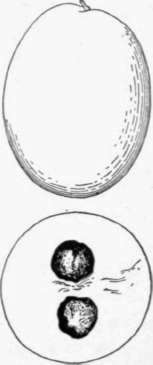From the Manual Of Tropical And Subtropical Fruits
by Wilson Popenoe
The Abiu
Pouteria Caimito, Radlk
Although the abiu is one of the best of the sapotaceous fruits, it
is not so widely cultivated as several other species. It greatly
resembles the canistel in habit of growth and in foliage, but is easily
distinguished from it by its light yellow fruit with white flesh. The
tree reaches 15 or 20 feet in height. The leaves are obovate to
lanceolate in outline, 4 to 8 inches long, acute, glabrous, and bright
green. The fruit is ovate-elliptic (occasionally almost round) in form,
2 to 4 inches long, and bright yellow in color, with skin thick and
tough. Surrounding the two or three large oblong seeds is the
translucent flesh, which in flavor resembles the sapodilla but is of
different texture. Until fully ripe it contains a milky latex which
coagulates on exposure to the air and sticks to the lips in a
troublesome manner.
Alphonse DeCandolle says of this species:
"It has been transported from Peru, where it is cultivated, to Ega on
the Amazon river, and to Para, where it is commonly called abi or abiu.
Ruiz and Pavon say it is wild in the warm regions of Peru, and at the
foot of the Andes." Jacques Huber reports that its culture is now
extensive at Para and elsewhere in the Amazon Valley. It is a common
fruit at Bahia and Rio de Janeiro, but outside of Brazil and Peru is
little known. Recently it has been introduced into the United States,
and should prove sufficiently hardy for cultivation in southern
Florida, although probably it is too tender for any part of California.
From its abundance in Para it can be judged that it delights in a moist
climate, uniformly warm throughout the year. It does well at Rio de
Janeiro, however, where the weather is cool during part of the year.

Fig. 46
Fig. 46. The abiu (Pouteria Caimito),
one of the best of the sapotaceous fruits. It is cultivated in Peru and
Brazil, rarely elsewhere. The skin is yellow, the flesh whitish,
melting, and sweet. (X 1/2) Lucuma Caimito, Roem., is a synonym of Pouteria Caimito,
Radlk. Because of its specific name caimito, this plant is sometimes
confused with the West Indian Chrysophyllum Cainito (star-apple, see
above), which is commonly known in Spanish as caimito. According to
Pittier, its name in the Cauca Valley of Colombia is caimo.
The
tree's cultural requirements are similar to those of the canistel. The
Brazilians say that a soil rich in humus is the most suitable.
Propagation is usually by seeds, but such vegetative means as budding
and grafting should be successful. Huber reports that there are many
seedling varieties at Para, differing in the form and size of the
leaves as well as in the fruits. The latter are sometimes round,
sometimes elongated ; in some the flesh is firm and in others soft and
mucilaginous; some are insipid in flavor while others are very sweet
and pleasant.
Back to
Abiu Page
|
|